
Lomax, H. and Casey, N.
(1998) 'Recording Social Life: Reflexivity and Video Methodology'
Sociological Research Online, vol. 3, no. 2,
<http://www.socresonline.org.uk/3/2/XXXX.html>
To cite articles published in Sociological Research Online, please reference the above information and include paragraph numbers if necessary
Received: 5/8/97 Accepted: 22/6/98 Published: 30/6/98
 Abstract
Abstract Introduction
Introduction
 Ignoring and
Marginalising the Video-Based Research Procedure
Ignoring and
Marginalising the Video-Based Research Procedure
 Video Research as
Distorting
Video Research as
Distorting
 Video Methods and
Reflexivity
Video Methods and
Reflexivity
If we are to make an empirical case for the effects of recording on interaction, then we need to demonstrate an orientation by the participants themselves to the production of their action and activity to some aspect of the recording equipment. (Heath, 1986: p. 176)
 1. Initiating the
Consultation
1. Initiating the
Consultation

SOUND FILE

SOUND FILE
'Right so how are you feeling then?' (S19)and
'Right so how's everything going? (S2).

SOUND FILE
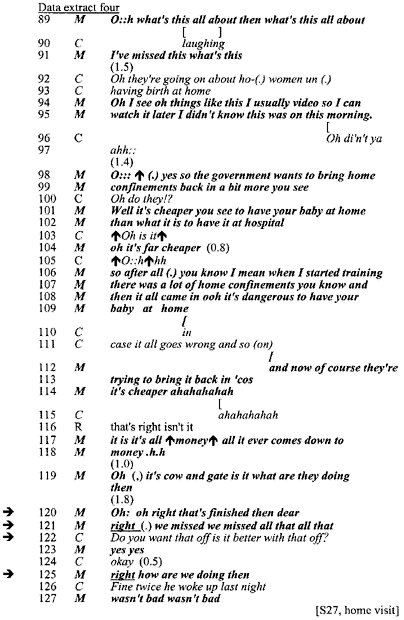
SOUND FILE

is evidence that she hears the midwife's utterance as closure. She takes a final step towards establishing an appropriate context for the visit (turning off the television) and then waits for the midwife to speak (pause between lines 124 and 125). The midwife's proceeding utterance:

marks the start of the business of the visit, constituting a summons for the client to talk on 'business'. In common with research on other health professionals (ten-Have, 1991; Robinson, 1987) our data reveals that midwives exercise the right to open the visit in this way, preferring a client response which co-operates in starting business (Lomax and Robinson, 1996).
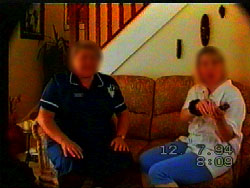
S27 Video still
122 C Do you want that off is it better with that off?
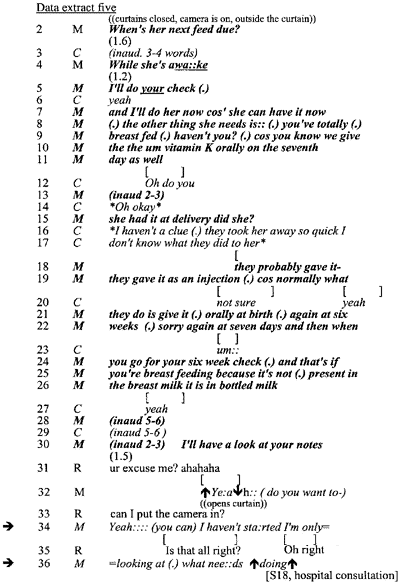
SOUND FILE
Videoed S7 on the 7th March. This was the first in a series of three videos carried out on the same day. Present were 'Sarah' [midwife], 'Mary' [mother], 'Veronica' [student midwife], a friend of Mary's and the baby. Mary's husband was working in the shop at the front of the house and did not participate in the visit . I arrived after everyone else and was directed to the lounge by him. On entering I was surprised to find everyone eating cake and drinking tea. The atmosphere was very jolly and there was a lot of laughter. The initial impression was that this was more like a party than a visit by a midwife. It was the tenth day so Sarah was discharging Mary, although this did not happen until later in the visit. As I arrived Mary got up and fetched me tea and cake which she was quite insistent that I accept. They were talking about all sorts of things not immediately identifiable as 'midwifery' concerns such as Mary saying the cake was baked by a friend and that people were especially welcome when they brought food. The 'business of the visit' - examination of mother and baby and accompanying paper work - did not start until 5 - 10 minutes after I arrived. I found this really problematic because I wanted desperately to record the interaction but felt socially unable to. Reflecting on this experience, while outwardly I accepted the cake, thanking Mary profusely for it and behaving (I think!) as if the situation I found myself in was un-problematic, inwardly my head was whirling with ideas: What are the implications for my data and most of all for my methodology chapter? On the positive side - data collection is going well - participants seem very ready to accept me. On the negative side, the apparent socially inappropriateness of switching on my camera means that I am missing some really interesting data. For better or worse I decided to go with my 'gut instinct' and leave the camera in its case. My feelings that it was inappropriate to video at this juncture appear to be confirmed by the way in which the initiation of the 'midwifery' activity of the visit was organised. The start of the encounter proper was characterised by Sarah draining her tea, putting down her cup, and getting out the patient notes, actions which were accompanied by her physical transition from the settee to the floor. (S7, home visit, field note diary)
Once I had set up the camera I left the room and went downstairs.. After about 5-10 minutes Sarina (the midwife) shouted to me 'we've finished', a statement which I interpreted as a summons to switch of the video camera, which I did. Reviewing this experience in the context of both the events which occurred during the visit after the camera had been switched off and the consultations videoed so far, it is becoming apparent that there are certain activities which the midwives construe as 'midwifery' and that they perceive I will be interested in researching (the physical examination, bathing the baby, helping mum breast-feed) and others which, although observable in each of the visits I will not be interested in ('social' talk occurring at the beginning and end of a visit, making arrangements for a subsequent visit). On this occasion, it being difficult to explain in the context of the visit that in fact I was interested in interaction other than that around the physical examination of the mother and child, I went along with the assumption and switched off the camera. However, my feelings of disappointment (that this data was not being video taped) grew as Sarina discussed with Paula the arrangements for the following visit, an activity which to an outsider like myself clearly constituted a midwifery activity. (S12, home visit, field notes)
And the video transcript from the same visit:
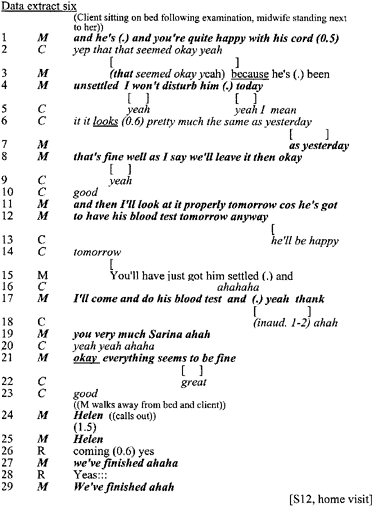
 2. Managing Non-
Participation
2. Managing Non-
Participation
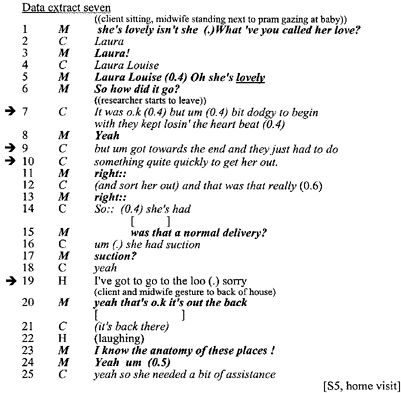
SOUND FILE

her footsteps can be heard on the stairs during the client's utterance at lines nine to ten:


Video-taped my fifth home visit today...... Having already experimented already with several ways of managing my presence during videoing, decided to try and leave the setting using the same departure strategy as I had with S3. On that occasion I discovered inadvertently that once out of the immediate environment it is possible to become engrossed in conversation with others until almost the end of the visit. In this way I am able to avoid becoming involved with the visit itself. Did not go entirely to plan. Decided to 'leave' by going to the bathroom. Leaving was okay, didn't feel it necessary to say anything as Isobel (midwife) and Carol (mother) were deep in conversation and any explanation would have constituted an interruption to proceedings. However, when I got to the top - no bathroom !! Rather embarrassingly, I had to make my way back down the stairs (which were in the lounge) and interrupt them in order to offer an explanation for my actions (in fact neither Carol or Isobel asked me what I had been doing however I felt obliged to account for wandering uninvited around a relative stranger's house). In fact, after being told where the bathroom was I managed to engage the client's mum (who had been hanging out washing) in conversation - she seemed happy to talk at length about the birth of her grandchild. In this way I managed to remain outside the lounge where the majority of the visit took place and uninvolved in the interaction for the most part of the consultation. (S5, home visit, field notes)

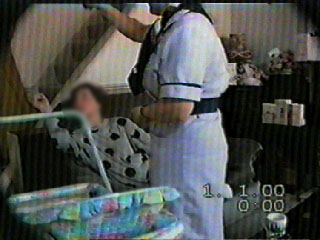
S5 Video Still: Midwife and client gesturing to the back of the house.

an utterance which both accounts for her knowledge of the layout of the house and her ability therefore to offer directions. But, importantly, it also offers a justification for her giving such information when she, like the researcher, is a guest in the client's house. In addition, both participants deal positively with the interruption. Directions to the loo are given, the midwife responds 'yeah that's okay', both laugh and , most importantly, the client's account of her labour is resumed moments later prompted by the midwife in line 24:

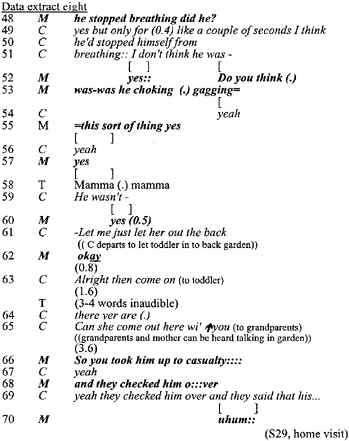
SOUND FILE


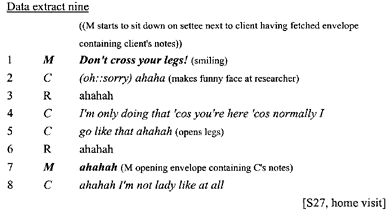
SOUND FILE
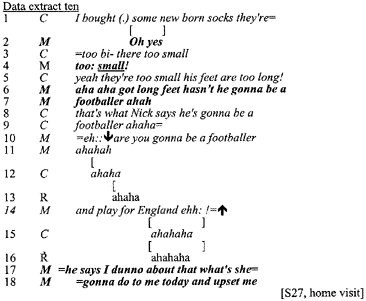
SOUND FILE

and 5;
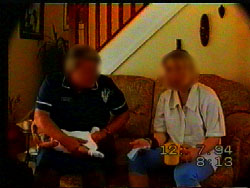

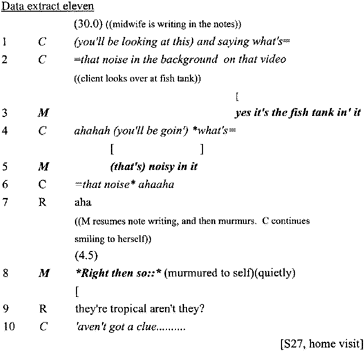
SOUND FILE
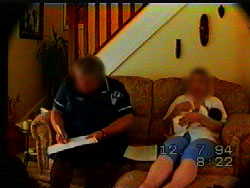
S27: Midwife writing in the notes


an utterance which generates a sequence of talk extending over several conversational turns during which the client and herself talk on the topic of fish- keeping.

SOUND FILE
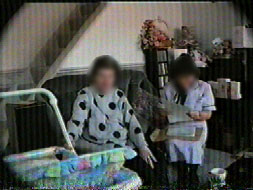
171 M Sorry it's a little bit lengthy with the paper work today

SOUND FILE
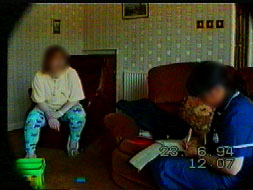
342 M pieces of paper everywhere
 3. Managing Body
Taboos
3. Managing Body
Taboos
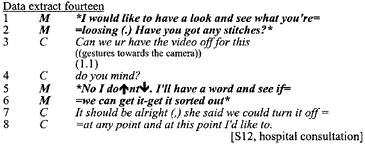
SOUND FILE
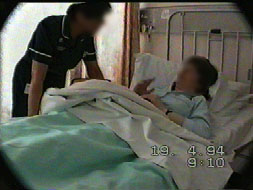
3 C Can we ur have the video off for this?
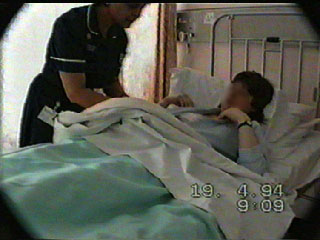
S12 Breast examination
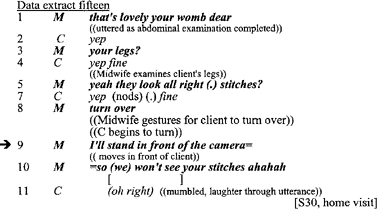
SOUND FILE
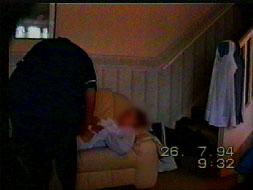
1 M that's lovely your womb dear
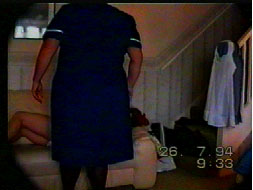
9 M I'll stand in front of the camera
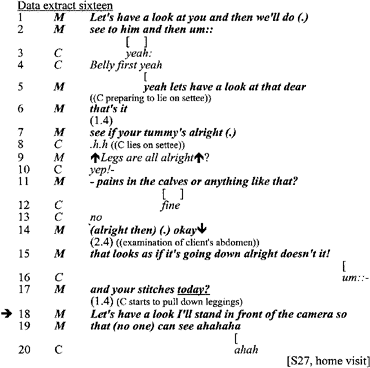
SOUND FILE
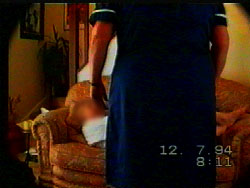
18 M Let's have a look I'll stand in front of the camera so that (no one) can see ahahaha
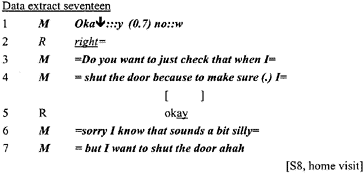
SOUND FILE
 Summary and
Conclusion
Summary and
Conclusion
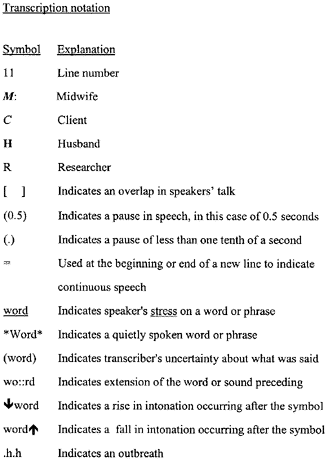
![]()
 Acknowledgements
Acknowledgements
ARBORELIUS, E. and TIMPKA, T. (1990) 'General Practitioners' Comments on Video Recorded Consultations as an Aid to Understanding the Doctor-Patient Relationship', Family Practice, vol. 7, no. 2, pp. 84 - 90.
BERGMANN, J (1990) 'On the Local Sensitivity of Conversation' in I. Markova and K. Foppa (editors) The Dynamics of Dialogue. New York: Harvester Wheatsheaf.
BERGSTROM, L.; ROBERTS, J.; SKILLMAN, L.; DEIDEL, J. (1992) '"You'll Feel Me Touching You Sweetie": Vaginal Examinations During the Second Stage of Labour', Birth, no. 19, pp. 10 - 18.
CARPENTER, L and MERKEL, T (1988) 'The Effects of Three Methods of Observation On Couples in Interactional Research', The American Journal of Family Therapy, vol. 16, no. 1.
EMERSON, J.P. (1970) 'Behaviour in Private Places: Sustaining Definitions of Reality in Gynaecological Examinations' in H.P. Dretzel (editor) Recent Sociology No. 2; Patterns of Communications Behaviour. Canada: Collier-Macmillan.
ERIKSON, F. and SCHULTZ, J. (1982) 'The Counsellor as Gatekeeper: Social Interaction in Interviews' in E. Hammel (editor) Language, Thought and Culture: Advances in the Study of Cognition. New York: Academic Press.
EIBL-EIBESFELDT, I. and HASS, H. (1974) 'Film Studies in Human Ethology', Current Anthropology, vol 8, no. 5, pp. 477 - 479.
FELD, S. and WILLIAMS, C. (1975) 'Towards a Researchable Film Language', Studies in the Anthropology of Visual Communication, pp. 25 - 32
FRANKEL, R. (1983) 'The Laying on of Hands: Aspects of the Organisation of Gaze, Touch and Talk in a Medical Encounter' in S. Fisher and A. Todd (editors) The Social Organisation of Doctor-Patient Communication. Washington D.C: The Centre for Applied Linguistics.
GOODWIN, C. (1981) Conversational Organisation: Interaction Between Speakers and Hearers. New York: Academic Press.
GOTTDIENER, M. (1979) Field Research and Video Tape. Sociological Inquiry, vol. 49, no. 4, pp. 59 - 66.
GRIMSHAW, A. (1982) Sound-Image Data Records for Research on Social Interaction: Some Questions Answered. Sociological Methods and Research, vol. 11, no. 2, pp. 121 - 144.
HAMMERSLEY, M. and ATKINSON, P. (1991) Ethnography: Principles in Practice. New York: Routledge.
HANSON, B. (1994) 'The Potential of Videotape Data: Emotional Correlates of Senile Dementia in Families as a Case in Point', Quality and Quantity, vol. 28, pp. 219 - 232.
HEATH, C (1986) Body Movement and Speech in Medical Interaction. Cambridge: University Press.
HEATH, C. and LUFF, P. (1993) 'Explicating Face- to-Face Interaction' in N. Gilbert (editor) Researching Social Life. London: Sage.
HEIDER, K (1976) Ethnographic Film. Austin (editor) Texas: University of Texas Press.
JEFFERSON, G. (1979) 'A technique for inviting laughter and its subsequent acceptance/declination' in G. Psathas (editor) Everyday Language: Studies in Ethnomethodology. New York: Irvington.
LIVINGSTONE, E. (1987) Making Sense of Ethnomethodology. London: Routledge and Kegan Paul.
LOMAX, H (1994) 'The Social Construction of Sexuality in Midwifery Postnatal Examinations: Some Preliminary Findings', British Sociological Association Annual Conference, University of Central Lancashire, 28th-31st March.
LOMAX, H. and ROBINSON, K (1996) 'Asymmetries in Interaction: An analysis of Midwife-Client Talk During the Postnatal Period', Proceedings of 24th Triennial Congress of International Confederation of Midwives. Oslo, Norway.
LUNDEVALL, S.; NJOLSTAD, I. and AARAAS, I (1994) 'Stop the Video and Involve the Observers: An Inter-Reflective Method to Stimulate Doctors' Learning about their Own Consultations with Patients', Medical Teacher, vol. 16, nos. 2/3, pp. 189 - 195.
MALLETT, J. (1990) 'Communication Between Nurses and Post-Anaesthetic Patients', Intensive Care Nursing, vol. 6, pp. 45 - 53.
MALLETT, J. (1993) 'Use of Humour and Laughter in Patient Care', British Journal of Nursing, vol. 2, no. 3, pp. 172 - 175.
MARTIN, E. and MARTIN, P. (1984) 'The Reactions of Patients to a Video Camera in the Consultation Room', Journal Royal College General Practitioners, vol. 34, pp. 607 - 610.
MURPHEY-BLACK, T. (1994) 'Care in the Community During the Postnatal Period' in S. Robinson and A.M. Thomson (editors) Midwives, Research and Childbirth. London, Chapman and Hall.
ROBINSON, K. (1987) The Social Construction Of Health Visiting. Unpublished PhD Thesis, Polytechnic of the South bank
RAGAN, S. (1990) 'Verbal Play and Multiple Goals in the Gynaecological Exam Interaction', Journal of Language and Social Psychology, vol. 9, nos. 1 - 2, pp. 67 - 84.
ROBSON, C. (1993) Real World Research. Oxford: Blackwell.
RIDER, A. (1984) 'Managment: A Manager's Approach to the Organisation of Normal Postnatal Care', Midwives Chronicle and Nursing Notes, October, pp. ii - iv.
SACKS, H. (1995) Lectures on Conversation. Cambridge, Massachusetts: Blackwell.
SCHEGLOFF, E. (1968) 'Sequencing in Conversational Openings', American Anthropologist, vol. 70, pp. 1075 - 95.
STARR, R. (1987) 'Clinical Judgements of Abuse- Proness Based on Parent-Child Interactions', Child Abuse and Neglect, vol. 11, pp. 87 - 92.
TEN-HAVE, P. (1991) 'Talk and Institution: A Reconsideration of the "Asymmetry" of Doctor-Patient Interaction' in D. Boden and D. Zimmerman (editors) Talk and Social Structure: Studies in Ethnomethodological Conversation Analysis. Polity Press: Cambridge.
VIHMAN, M. and GREENLEE, M. (1987) 'Individual Differences in Phonological Development: Ages One and Three Years', Journal of Speech and Hearing Research, vol. 30, pp. 503 - 521.
VUCHINICH, S. (1986) 'On Attenuation in Verbal Family Conflict', Social Psychology Quarterly, vol. 49, no. 4, pp. 281 - 293.
WEIMANN, J. (1981) 'Effects of Laboratory
Videotaping Procedures on Selected Conversation Behaviours', Human
Communication Research, vol. 7, no. 4, pp. 302 - 311.
